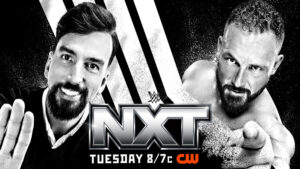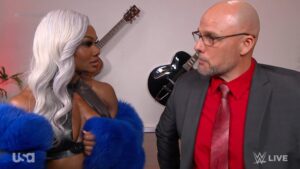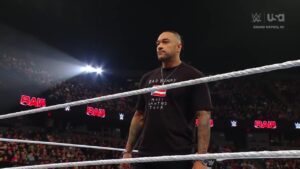This week’s episode of Dark Side of the Ring, Becoming Warrior, focused on The Ultimate Warrior. From the late 1980s to the early 90s, The Ultimate Warrior was one of the most popular stars in the World Wrestling Federation. While he enjoyed success as a two-time Intercontinental Champion and one-time WWF Champion, he was also one of the most controversial figures in wrestling. This episode, airing the same week as the A&E Biography episode on the man himself, saw figures ranging from Jake “The Snake” Roberts to Warrior’s first wife, Shari Tyree, recall key events from his life. Here’s what viewers learned coming out of the Becoming Warrior episode.
Jim Hellwig, AKA The Ultimate Warrior, was a figure shrouded in self-doubt.
According to his first wife, Shari, he had insecurities. It showed that, in entertainment, not everything was as it seemed. On their first date, Shari was taken by surprise when Hellwig “took out the trash,” as he got involved in a physical altercation with a stranger. She also learned that he was a chiropractic student.
During his time in school, Hellwig became fascinated with bodybuilding.
The idea of members of his family dying in their 50s seemed to shift his focus to athletics. His goal, according to Shari, was to become rich and famous. Hellwig was devoted to this. On October 2, 1992, Hellwig and Shari became married. Shortly thereafter, Hellwig focused on bodybuilding.
Hellwig befriended a young Steve Borden, also known as Sting.
They would become involved in wrestling together, starting in Memphis under Jerry Jarrett. Jim Cornette was not a fan of Hellwig. While he saw his and Borden’s first match as “rotten,” he noted their charisma. However, they needed to be somewhere where they could learn. From there, Hellwig and Borden moved to Mid-South Wrestling.
Jim Ross was a broadcaster when The Blade Runners arrived in the Universal Wrestling Federation.
Hellwig and Borden soon became The Blade Runners, Hellwig known as Blade Runner Rock and Borden as Blade Runner Sting. Jim Ross saw Hellwig was “narcissistic,” while Borden was regarded as more trainable and better liked. During this time, Shari saw a more “selfish” side to her husband. The Blade Runners had differing ideas of what they wanted to accomplish in wrestling. When Hellwig parted ways with Borden, the former made his way to World Class Championship Wrestling.
It was in WCCW where The Dingo Warrior was born.
David Manning, former WCCW Booker, stated how they created the star the company wanted: The Dingo Warrior. The idea was that he was a “wild dog” type of character, which fit him as a heel during the time. His first ten to fifteen matches were squashes. All the while, crowds cheered him. The more fans cheered, according to Manning, the bigger the Warrior’s ego became. Cornette believed that Hellwig’s main goal was to become famous. This would ultimately lead the Warrior to the World Wrestling Federation.
In 1987, Jim Hellwig was invited to the WWF.
Shari saw this as an event that would change the dynamic of their marriage. Following this, Hellwig would be on the road most days of the year. Starting out, he wrestled enhancement matches. During this time, he needed to figure out what he wanted to do with his character. He entered the company as The Dingo Warrior, though he would go by his more recognizable name in due time.
Vince McMahon didn’t like The Dingo Warrior name, which changed everything.
McMahon liked the Warrior’s intensity, which was dialed up with techniques such as shaking the ropes. The Ultimate Warrior would also be billed as from “Parts Unknown,” adding to the character’s mystery. His unique promos were described, by Eric Bischoff, as “nonsensical as best.” In real life, Hellwig would crack himself up after cutting promos, wondering what he just said. To Shari, his iconic entrance theme was the catalyst for his success as The Ultimate Warrior.
The Ultimate Warrior became a merchandising vehicle.
His most favorite piece of merchandise, according to Shari, was his WWF Wrestling Buddy. “Macho Man” Randy Savage, Hulk Hogan, and other WWF Superstars were included in this series.
The Ultimate Warrior didn’t have many allies.
Jake Roberts and Bobby Heenan didn’t like him, largely due to the Warrior’s reckless offense. When others spoke about how bad of a wrestler he was, Hellwig second-guessed himself. To Shari, there was more to him, as he was relatively insecure, especially growing up with a scrawny frame and his father leaving home early in his life. This trauma seemed to travel with him throughout his life.
In 1990, The Ultimate Warrior was one of the biggest stars in the company.
His crowning moment came at WrestleMania VI, where he faced Hulk Hogan in a title-for-title match. While Hulk Hogan was the WWF Champion, The Ultimate Warrior was the Intercontinental Champion. The Ultimate Warrior learned that he would be taking Hogan’s spot as the top star, which spurred great anxiety. McMahon didn’t want “Hulkamania” to become stale. Additionally, Hogan was beat up and needed a break. Warrior’s victory marked the first time Hogan was beaten cleanly, and decisively, in the company.
Following The Ultimate Warrior’s WWF Championship win at WrestleMania VI, things took a turn for the worse.
According to Shari, two months later, “Jim Hellwig left and The Ultimate Warrior came home.” He became erratic and disconnected. Hellwig would also stay on the road, which he never did before. Shari called her husband’s hotel room, and when she got through, she heard a girl’s voice. Distraught, Shari went through his belongings, including his planner that detailed a girl’s name and the town on different pages. From there, she told him that when he comes home, he’ll be served divorce papers. At that moment, her worst fear came true. They officially divorced in 1991.
Not long after, The Ultimate Warrior lost the WWF Championship.
This was when his relationship with McMahon began to deteriorate. During this same time, Roberts was set to work a feud with Warrior. However, McMahon told Roberts to get the “okay” from Warrior, saying it was the way it had to be done. When Roberts approached Warrior, the latter snapped. Warrior expressed his only desire was to make money. Plans for said feud would soon be derailed as Warrior and McMahon’s relationship continued to sour.
Warrior drafted a letter to McMahon saying that he wanted the same money as Hogan.
Warrior would present Shari with this letter. She responded negatively, knowing that it would end badly. At the SummerSlam 1991 pay-per-view, Warrior delivered the letter to McMahon. He stated that unless he was financially compensated, as he wanted, he wouldn’t compete at the event. Shari also saw this as a call for attention from McMahon, seeing their relationship akin to a father and son. McMahon temporarily placated the demands, though had no intention to follow up with them.
When The Ultimate Warrior stepped back through the curtain, following the match, McMahon immediately dismissed him.
McMahon turned to Roberts, telling him he had the worst luck of any human being he had ever met. Roberts was incensed, knowing he just missed out on a big-money feud. McMahon sent Warrior a letter in return, saying that he was a legend in his own mind. Cornette has kept a copy of the letter.
Following his first firing with the WWF, Jim Hellwig changed his legal name to “Warrior.”
This was done as a way for Hellwig to maintain control of his character. According to Shari, she believed it was carried out so he could reinvent himself, as he expressed interest in using said character for other projects.
Vince McMahon would approach The Ultimate Warrior for a second chance in the WWF. This led to company officials learning of “destrucity.”
During this business meeting, Warrior spoke about “destrucity,” a term he coined. This term defined the truth between destiny and reality, staying true to oneself while achieving goals. Jim Ross saw this as “a total waste of a trip.” Nonetheless, Warrior returned to the company at WrestleMania XII.
At WrestleMania XII, Warrior faced a young Hunter Hearst Helmsley.
Hunter Hearst Helmsley, better known today as Triple H, was defeated in short order. During this infamous match, Warrior no-sold most of his opponent’s offense. By this time, however, things had changed in terms of fan perception. Merchandise wasn’t selling as well and “destrucity” hadn’t caught on, either. Shortly thereafter, Warrior would part ways with the WWF before opening his bodybuilding gym.
During this time, Warrior reconnected with Shari.
They would go on to meet their future significant others. Warrior and Shari were soon back on friendly terms. When Shari became pregnant, she and Warrior decided they should no longer associate with one another. Warrior thanked her for all she did and apologized for the pain he caused her. This was the last time Shari saw Warrior.
Over the next decade, Warrior became a conservative motivational speaker.
Through his future wife, Dana, Warrior learned that he possessed conservative values. His speeches would draw considerable controversy, as he targeted different cultures and beliefs. Warrior would also speak out about others in the business.
After spending years in lawsuits with World Wrestling Entertainment, Warrior entered the WWE Hall of Fame Class of 2014.
During the ceremony, Roberts was prepared to fight Warrior over their past transgressions. Warrior approached Roberts, apologizing to him and his family. Roberts believed he received “a lesson in life” at that moment. Warrior also made amends with others, including McMahon himself. This seemed like an improbable storybook ending.
The next night, on Monday Night Raw, Warrior cut an inspirational promo in his final on-screen appearance.
He concluded the promo by declaring, “the spirit of The Ultimate Warrior will run forever.” Jim Ross noted he looked fatigued during the segment. The following morning, twelve hours after the appearance, he was walking to his car when he suffered a heart attack and passed away.
Stay tuned to the Last Word on Pro Wrestling for more on this and other stories from around the world of wrestling, as they develop. You can always count on LWOPW to be on top of the major news in the wrestling world, as well as to provide you with analysis, previews, videos, interviews, and editorials on the wrestling world. Catch Dark Side of the Ring on VICE, with new episodes airing each Thursday at 9 PM EST.
Looking to talk wrestling, pro football, or any number of sports? Head on over to the LWOS Boards to engage in conversation with fellow fans!






